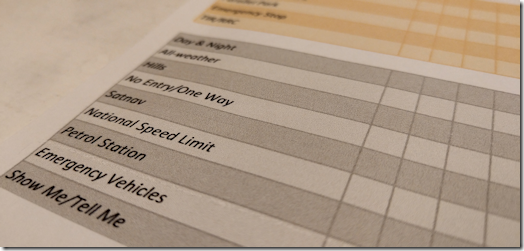 In normal times, when someone goes out on their driving test, it is quite possible for them to ‘fail’ before they even leave the test centre if they mess up on the bay park, for example (or try to take out the test centre gate on their way out). However, in the vast majority of cases the test still continues for the allotted time of around 40 minutes.
In normal times, when someone goes out on their driving test, it is quite possible for them to ‘fail’ before they even leave the test centre if they mess up on the bay park, for example (or try to take out the test centre gate on their way out). However, in the vast majority of cases the test still continues for the allotted time of around 40 minutes.
Occasionally, if someone has a meltdown, the examiner might decide to terminate the test early. In Nottingham, the examiners are all decent people, and what they usually do under such circumstances is guide the test back to the test centre and terminate it early there. Only in the more dramatic cases (or with one examiner at Watnall, who I haven’t seen for a while) do they do an abandonment, leaving the car wherever it is at the time. This can happen when the candidate is simply unable to continue or to drive safely. The last one of those I had was some years ago, where the the candidate had committed a simple mistake, which she realised, and which – in the examiner’s own words – was not a serious fault anyway, but she went on to have a full breakdown, was in fits of tears, and simply couldn’t continue.
In normal times, I have no issue whatsoever with whatever the examiner decides (even that one at Watnall). Some pupils, though, are furious to discover that even though they ‘failed’ early on, they were still given a full 40 minute test. ‘What’s the point?’ is their usual question, whereupon I explain that that’s the system, and they’ve paid for 40 minutes of test time and it makes sense to get the experience in full. Examiners are damned if they do, and damned if they don’t.
Right now, of course, we’re not in normal times. No normal tests were carried out between the end of March and August, and since they restarted there are obviously a lot of extra details we all have to be aware of, making them far from normal normal.
The majority of test candidates are young people, and the majority of young people are students. Unless you live under a rock, or in accommodation provided by QAnon, it won’t have escaped your attention that there has been a huge spike in the numbers of positive COVID-19 tests, and many of those are among students. Conversely, the majority of driving examiners are not young people, and many of them are in the demographic where the prognosis for a positive COVID-19 test is not good – for them, and quite possibly members of their immediate family.
As I have explained in recent articles, in the last month I have had to stop lessons for a student whose sister was sent into quarantine after members of staff at the school she worked at tested positive. I stopped lessons for another who was sent into quarantine after a staff member at his workplace tested positive (and I discovered today he also became positive last week). Another texted me last week to tell me he had been sent home from school to quarantine because his teacher had tested positive. And I have heard that an examiner has had to quarantine because someone took a driving test a couple of weeks ago and tested positive the following day (and that one raises a lot of unanswered questions about the candidate, their morals, and their intelligence). I also spoke with one of my student pupils who went home at the start of the lockdown and has recently come back, and he tells me his accommodation outside the university has numerous people who are positive and supposedly quarantining.
The COVID-19 infection path is complicated, and doesn’t follow the simple rules most people don’t understand even then. Technically, it would be possible just to come into contact with a single viral particle and get infected. However, the risk of infection increases in line with the number of viral particles you are exposed to, the frequency of exposure, and the length of time you are exposed to them. It’s a triple whammy. The more infected people there are, and the more time you spend around them, the greater the risk. It’s the same principle for most viruses and infectious agents, and COVID-19 is no different – other than there being no vaccine for it yet. This is why we have the various measures in place for trying to manage it, and it is no wonder that responsible people and organisations are following them, instead of trying to argue that they are wrong.
As I have repeatedly said, the situation we are in is far from normal. Rightly or wrongly, the decision was made to try and resume some level of normality following the lockdown. That eventually led to the resumption of driving tests – along with a raft of changes to how they are carried out. These include:
- masks must be worn
- test centre waiting rooms are closed – largely because they’re being used by examiners who are socially distancing in their workplaces as best they can (and even if they’re not, having ADIs in there would raise major distancing and sanitization issues)
- tests are ‘terminated’ as soon as a serious/dangerous fault is committed, and the candidate is directed back to the test centre
- instructors cannot accompany tests
- instructors cannot listen in on the debrief
The reality – in Nottingham, anyway – is that there is absolutely no issue using the toilets in the test centre if you ask (I should say, ‘ask nicely’, but then I am always polite with examiners). As long as you are wearing a mask and don’t try to climb on the examiner’s shoulder by hanging through the door, there would appear to be no real issues with listening to the debrief from a safe distance, Even if you don’t, the examiner will likely have a quick chat outside. The only downer to all this is that if it pissing down with rain, you’ll get wet while the test is out unless you’ve taken steps to deal with it (and I have).
This is how it is in these very un-normal times. People tend to forget that it’s only been like this with driving tests for a couple of months, and with a vaccine likely on the way, it probably won’t be like it for that many more. I mean, Christ! Assuming there is a vaccine by Christmas, it means that we’ve had to struggle for barely a year with the whole pandemic (notwithstanding the false dawn in the middle, which has caused the resurgence we have today). And as much as I hate bringing the past into things, people had to put up with much, much worse restrictions and conditions during – and for a decade after – the Second World War. Standing in the rain for 40 minutes is hardly on the same scale.
But people are different today, and THIS is why we have problems. To start with, there is a large number of ADIs who are apparently card-carrying QAnon members and anti-vaxxers. From what I have seen, those who usually spend the better part of their time criticising DVSA over every single matter are the ones most likely to be among these. The word ‘contrarian’ springs to mind. Consequently, they know best about masks. I mean, within 5 minutes of the rule being sent out, the message boards were immediately filled by contrarian ‘what if…’ questions, and it would appear that 90% of instructors only teach people who have asthma, and have asthma themselves – even though a genuine asthmatic would not have that much of a problem with a mask in the first place.
The reason I know that is that shortly after I started lessons again, one of my pupils had an emergency test booked. She has health conditions and is asthmatic, so I phoned her and explained the rules that had been sent out. I explained that unless a specific exemption had been mentioned at the time of booking, there was – from what I had heard from other instructors – the possibility that her examiner might refuse to go out. She resolved the issue for me immediately by saying ‘oh, I’ll just wear a mask then’. She did, and she passed. She also needed to use the loo as we arrived, and an examiner came to the door as she approached and let her in without question. Don’t get me wrong. I’m sure there really are people out there who genuinely cannot wear mask, but it’s nowhere near as many as some would like it to be, and asthma is not an automatic barrier unless it is accompanied by a dose of attitude.
Then there’s the waiting room issue. Yes, I would like to sit in the warm. But I can see with my own eyes that the examiners are using the waiting area (at Colwick, anyway) as an office space to help them socially distance inside. So, at the moment – in these un-normal times – there is no waiting room. It isn’t like I’ve not experienced a test centre with no waiting room before. There wasn’t one when when the Chilwell centre was first relocated, and there wasn’t one when there was a centre in Clifton. And none of them in Nottingham are actually located that close to a café or other place with refreshments (unless you include a pub in Watnall, which I have never seen any instructor enter). Of course, once this waiting room thing was publicised, we quickly discovered that most driving instructors apparently suffer from any or all of arthritis, rheumatism, dodgy bladders, and a variety of other ailments for which one of the specific triggers is apparently not being able to sit in the test centre waiting room.
Now we come to test terminations. Naturally, as well as being experts on every other subject (even though they never agree on the answer to simple driving-specific issues), it turns out ADIs see themselves as compensation lawyers, too. They’re actually trying to bolster each other up into starting petitions because it’s ‘grossly unfair’, and some sort of money-making scam by DVSA. They blame the backlog of tests on DVSA, readily apportioning blame when one of their pupils can’t get a test until next year.
For f***’s sake, people. It is what it is. We’re in the middle of a pandemic which has killed 50,000 people in the UK in little more than six months, with every sign it has come back for a bigger go. It spreads by close contact, and examiners are in one of the worst positions imaginable for it to do that. We only have our own pupils to deal with. They have to deal with all of us, and all of our pupils. And as I’ve already pointed out, a fair few of us are, unfortunately, militant deniers, anti-maskers, and anti-vaxxers – and that’s on top of being inveterate DVSA-haters. Examiners are therefore far more at risk from these nutcases than I am. I just stay away from them, but examiners can’t.
My justification for starting lessons again in late August/early September was based on the low number of infections being reported at the time. The risk of coming into contact with an infected person was low. My justification for stopping lessons again now is that the number of infections has gone through the roof, and every one of my pupils either knows someone or is someone who is infected. The risk of me becoming infected is virtually guaranteed if I continue.
And none of that makes me want to start f***ing whingeing about wearing a mask, not being able to use the waiting room, or having a test return early if someone screws up. Because as I said.
It.Is. What. It. Is. Right. Now.
 As if it wasn’t already obvious – and it wasn’t to many ADIs out there –
As if it wasn’t already obvious – and it wasn’t to many ADIs out there – 
 An
An  This story has been doing the rounds since yesterday
This story has been doing the rounds since yesterday
 In normal times, when someone goes out on their driving test, it is quite possible for them to ‘fail’ before they even leave the test centre if they mess up on the bay park, for example (or try to take out the test centre gate on their way out). However, in the vast majority of cases the test still continues for the allotted time of around 40 minutes.
In normal times, when someone goes out on their driving test, it is quite possible for them to ‘fail’ before they even leave the test centre if they mess up on the bay park, for example (or try to take out the test centre gate on their way out). However, in the vast majority of cases the test still continues for the allotted time of around 40 minutes. At the start of 2020, DVSA announced they were planning to make some changes to the theory test. Any planned schedule for that went right out of the window when COVID-19 came along. However, with things firing on two or three cylinders again,
At the start of 2020, DVSA announced they were planning to make some changes to the theory test. Any planned schedule for that went right out of the window when COVID-19 came along. However, with things firing on two or three cylinders again,  Well, I had my first post-lockdown test today, and she passed with six driver faults. Well done to her!
Well, I had my first post-lockdown test today, and she passed with six driver faults. Well done to her!




